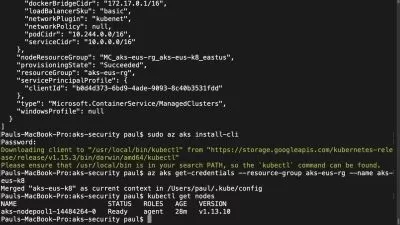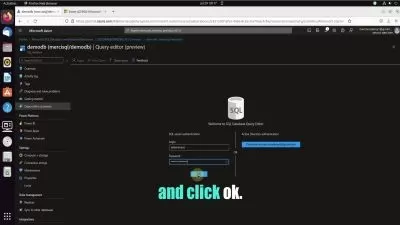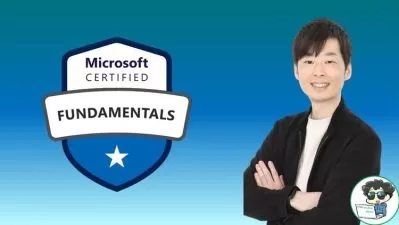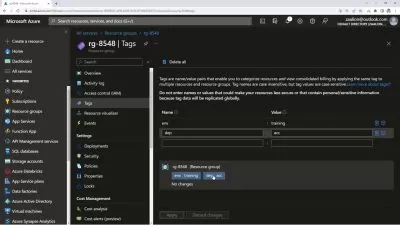AZ-900 Microsoft Azure Fundamentals with SIMULATIONS
John Christopher
9:14:48
Description
Get prepared for the AZ-900 exam with instructor led labs and hands on simulations available 24/7
What You'll Learn?
- Learn the concepts and perform hands on activities needed to pass the AZ-900 exam
- Gain a tremendous amount of knowledge involving Microsoft Azure Services
- Get loads of hands on experience with Microsoft Azure Services
- Utilize hands on simulations that can be access anytime, anywhere!
Who is this for?
More details
DescriptionWe really hope you'll agree, this training is way more than the average course on Udemy!
Have access to the following:
Training from an instructor of over 20 years who has trained thousands of people and also a Microsoft Certified Trainer
Lecture that explains the concepts in an easy to learn method for someone that is just starting out with this material
Instructor led hands on and simulations to practice that can be followed even if you have little to no experience
TOPICS COVEREDÂ INCLUDINGÂ HANDSÂ ONÂ LECTUREÂ ANDÂ PRACTICEÂ TUTORIALS:
Introduction
Welcome to the course
Understanding the Microsoft Environment
Having a Solid Foundation of Active Directory Domains
Having a Solid Foundation of RAS, DMZ, and Virtualization
Having a Solid Foundation of the Microsoft Cloud Services
Order of concepts covered in the course
Questions for John Christopher
Setting up for hands on
IMPORTANT Using Assignments in the course
Creating a free Azure Account
Activating Azure AD P2 license
Describe cloud computing
Define cloud computing
Describe the shared responsibility model
Define cloud models and Identify use cases for each cloud model
Describe the consumption-based model
Compare cloud pricing models
Describe the benefits of using cloud services
Describe the benefits of high availability and scalability in the cloud
Describe the benefits of reliability and predictability in the cloud
Describe the benefits of security and governance in the cloud
Describe the benefits of manageability in the cloud
Describe cloud service types
Describe infrastructure as a service (IaaS)
Describe platform as a service (PaaS)
Describe software as a service (SaaS)
Identify appropriate use cases for each cloud service (IaaS, PaaS, SaaS)
Describe the core architectural components of Azure
Describe Azure regions, region pairs, and sovereign regions
Describe availability zones and Azure datacenters
Describe Azure resources and resource groups
Describe subscriptions
Describe management groups
Describe the hierarchy of resource groups, subscriptions, and management groups
Describe Azure compute and networking services
Compare compute types, including container instances, virtual machines (VMs), and functions
Create an Azure Virtual Machine
Describe VM options, including Azure Virtual Machines, and availability sets
Describe Azure Virtual Machine scale sets
Describe resources required for virtual machines
Describe application hosting options, including the Web Apps feature of Azure App Service
Describe virtual networking, including the purpose of Azure Virtual Networks, Azure virtual subnets, peering, Azure VPN Gateway, and Azure ExpressRoute
Create virtual networks and subnets
Define service and private endpoints
Describe Azure storage services
Compare Azure storage services and Describe storage account options and types
Create an Azure storage account
Describe file shares and storage tiers
Describe redundancy options
Identify options for moving files, including AzCopy, and Azure Storage Explorer
Describe migration options, including Azure Migrate and Azure Data Box
Describe Azure identity, access, and security
Describe directory services in Azure, Azure AD, Microsoft Entra & Azure ADDS
Describe authentication methods in Azure, SSO, MFA & passwordless
Creating single users, bulk users, and external identities/guest access in Azure
Describe Azure role-based access control (RBAC)
Describe the concept of Zero Trust
Describe the purpose of the defense in depth model
Describe the purpose of Microsoft Defender for Cloud
Describe cost management in Azure
Describe factors that can affect costs in Azure
Azure Pricing calculator, Azure Cost management and Billing
Describe the purpose of tags
Describe features and tools in Azure for governance and compliance
Describe the purpose of Azure Blueprints
Describe the purpose of Azure Policy
Describe the purpose of resource locks
Describe the purpose of the Service Trust Portal
Describe features and tools for managing and deploying Azure resources
Describe the Azure portal
Describe Azure Cloud Shell with Azure PowerShell
Describe Azure Cloud Shell with Azure CLI
Describe the purpose of Azure Arc
Describe Azure Resource Manager and Azure Resource Manager templates (ARM templates)
Describe monitoring tools in Azure
Describe the purpose of Azure Advisor
Describe Azure Service Health
Describe Azure Monitor Features
Describe Azure Monitor Alerts
FINAL - Where do I go from here?
BONUS Lecture
Who this course is for:
- IT people interested in learning and passing the Microsoft AZ-900 exam!
- IT people interested in learning a tremendous amount about Microsoft Azure Services!
We really hope you'll agree, this training is way more than the average course on Udemy!
Have access to the following:
Training from an instructor of over 20 years who has trained thousands of people and also a Microsoft Certified Trainer
Lecture that explains the concepts in an easy to learn method for someone that is just starting out with this material
Instructor led hands on and simulations to practice that can be followed even if you have little to no experience
TOPICS COVEREDÂ INCLUDINGÂ HANDSÂ ONÂ LECTUREÂ ANDÂ PRACTICEÂ TUTORIALS:
Introduction
Welcome to the course
Understanding the Microsoft Environment
Having a Solid Foundation of Active Directory Domains
Having a Solid Foundation of RAS, DMZ, and Virtualization
Having a Solid Foundation of the Microsoft Cloud Services
Order of concepts covered in the course
Questions for John Christopher
Setting up for hands on
IMPORTANT Using Assignments in the course
Creating a free Azure Account
Activating Azure AD P2 license
Describe cloud computing
Define cloud computing
Describe the shared responsibility model
Define cloud models and Identify use cases for each cloud model
Describe the consumption-based model
Compare cloud pricing models
Describe the benefits of using cloud services
Describe the benefits of high availability and scalability in the cloud
Describe the benefits of reliability and predictability in the cloud
Describe the benefits of security and governance in the cloud
Describe the benefits of manageability in the cloud
Describe cloud service types
Describe infrastructure as a service (IaaS)
Describe platform as a service (PaaS)
Describe software as a service (SaaS)
Identify appropriate use cases for each cloud service (IaaS, PaaS, SaaS)
Describe the core architectural components of Azure
Describe Azure regions, region pairs, and sovereign regions
Describe availability zones and Azure datacenters
Describe Azure resources and resource groups
Describe subscriptions
Describe management groups
Describe the hierarchy of resource groups, subscriptions, and management groups
Describe Azure compute and networking services
Compare compute types, including container instances, virtual machines (VMs), and functions
Create an Azure Virtual Machine
Describe VM options, including Azure Virtual Machines, and availability sets
Describe Azure Virtual Machine scale sets
Describe resources required for virtual machines
Describe application hosting options, including the Web Apps feature of Azure App Service
Describe virtual networking, including the purpose of Azure Virtual Networks, Azure virtual subnets, peering, Azure VPN Gateway, and Azure ExpressRoute
Create virtual networks and subnets
Define service and private endpoints
Describe Azure storage services
Compare Azure storage services and Describe storage account options and types
Create an Azure storage account
Describe file shares and storage tiers
Describe redundancy options
Identify options for moving files, including AzCopy, and Azure Storage Explorer
Describe migration options, including Azure Migrate and Azure Data Box
Describe Azure identity, access, and security
Describe directory services in Azure, Azure AD, Microsoft Entra & Azure ADDS
Describe authentication methods in Azure, SSO, MFA & passwordless
Creating single users, bulk users, and external identities/guest access in Azure
Describe Azure role-based access control (RBAC)
Describe the concept of Zero Trust
Describe the purpose of the defense in depth model
Describe the purpose of Microsoft Defender for Cloud
Describe cost management in Azure
Describe factors that can affect costs in Azure
Azure Pricing calculator, Azure Cost management and Billing
Describe the purpose of tags
Describe features and tools in Azure for governance and compliance
Describe the purpose of Azure Blueprints
Describe the purpose of Azure Policy
Describe the purpose of resource locks
Describe the purpose of the Service Trust Portal
Describe features and tools for managing and deploying Azure resources
Describe the Azure portal
Describe Azure Cloud Shell with Azure PowerShell
Describe Azure Cloud Shell with Azure CLI
Describe the purpose of Azure Arc
Describe Azure Resource Manager and Azure Resource Manager templates (ARM templates)
Describe monitoring tools in Azure
Describe the purpose of Azure Advisor
Describe Azure Service Health
Describe Azure Monitor Features
Describe Azure Monitor Alerts
FINAL - Where do I go from here?
BONUS Lecture
Who this course is for:
- IT people interested in learning and passing the Microsoft AZ-900 exam!
- IT people interested in learning a tremendous amount about Microsoft Azure Services!
User Reviews
Rating
John Christopher
Instructor's Courses
Udemy
View courses Udemy- language english
- Training sessions 68
- duration 9:14:48
- Release Date 2022/12/18














